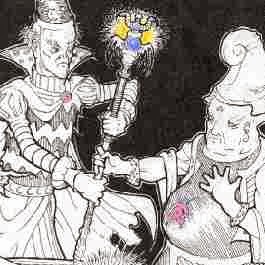 |
| That I haven’t used these three ugly mugs as NPCs in a campaign yet is an absolute travesty. |
And yet, the cut-and-dried nature of a simple ‘shot counter’ just takes away a bit of the mystery and uncertainty that should lie at the heart of powerful magics pretty much everywhere in the game. Discussing the game with my son in the car, we devised a neat method for these items that gives players some idea of how much energy they’ve got to play with, but leaves the exact amount open to some level of uncertainty. It also gives the three items their own flavor.
- Rods – weakest of the three, the powers of rods are either so powerful you only get one use (such as a rod of cancellation) or so limited to low power things that won’t break the game (like the immovable rod).
- Wands – the tool of a wizard, these are basically portable spell holders. How many spells? Hard to say. Each wand is given a die-type, known to the player, that is rolled every time the wand is used. If that die comes up 1, then the last charge has been used. Weak wands, like minor illusion, can be assigned a d20, so you can suspect a high number of uses. Powerful wands, like chain lightning, you’ll get an average of 4 uses, maybe more, maybe less.
- Staves – Staves are a little more reliable than wands, but still not completely predictable. Staves work similarly, each is assigned a die-type, and that die is rolled every time the staff is used. For these items, when the die comes up between 1 and 3, the die-type drops by one (i.e. the staff drops from a d20 to a d12). That means staves have a lot more charges, and you have a much better idea how much more use the staff can handle. You can even assign different dice to different powers of staves – consider a healing staff that has a d20 cure light, but a d4 raise dead. It’s easy to see which one the players will get more use out of.
This gives you the same resource management sub-game, without having to track individual charges. It gives the players some idea how much they can rely on an item, but doesn’t leave them holding a dozen wands each with one charge left, you know, just in case.
